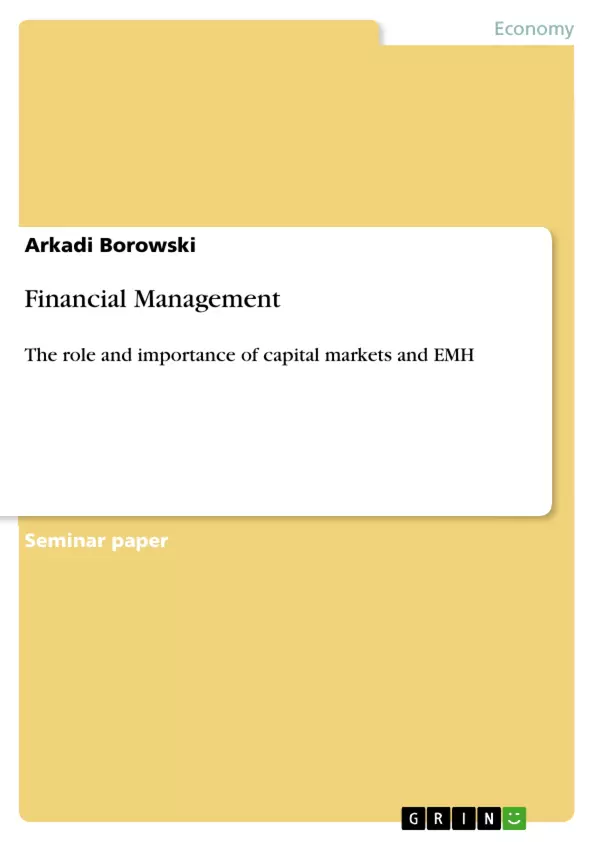The role and importance of capital markets and EMH
Crisp plc has to attract investments from capital markets.
A capital market is simply any market where a government or a company (usually a
corporation) can raise money (capital) to fund their operations and long term (periods longer
than a year) investment.[1] Usual, short-term funds can be founded on other markets (e.g., the
money market). The capital market consists of the stock market (equity securities) and the bond
market (debt). Bonds and stocks are two ways to generate capital of any company.
New issues of bonds and stocks are placed on primary capital markets by way of
underwriting among investors. All money, received during underwriting, goes to company (Crisp
plc) for its investment purposes.
And placed bonds and stocks are sold and bought among other investors or traders in the
secondary capital markets (a securities exchange, over-the-counter, or elsewhere). The prices of
securities (both bonds and stocks) on secondary markets are reflected «real» price of company.
It is good benchmark for primary placements of additional issues of bonds and/or stocks (further
extension of the company).
Crisp plc is going to issue bond or stocks. It means that it attract money from primary
markets. Here very important thing is true price of bonds and/or stocks of Crisp plc, i.e. price has
to be interesting for investors and allows to attract maximum of money.
As stated above, prices of securities on secondary markets are reflected «real» price of
company from point of view of investors. Here the efficient-market hypothesis (EMH) plays
very important role, because it is the tool of securities pricing of off-site investors (which are
outside of the company).
According to the efficient-market hypothesis (EMH), which was developed by Professor
Eugene Fama, financial markets are «informationally efficient».[2] It means that prices on traded
assets are «real» and already reflect all known information. Prices change to reflect new
information (for example, new investment program of the company). Consequently, it is
impossible to consistently outperform the market by using any information that the market
already knows. Information or news in the EMH is defined as anything that may affect prices
that is unknowable in the present and thus appears randomly in the future.
Inhaltsverzeichnis (Table of Contents)
- Task 1
- The role and importance of capital markets and EMH
- Task 2
- The different sources of finance available to large companies and the impact on cost of capital
- Task 3
- The practical aspects of the dividend decision and a critical evaluation of the theories of relevance and irrelevance of dividends to share valuation
- References
Zielsetzung und Themenschwerpunkte (Objectives and Key Themes)
The text analyzes the role and importance of capital markets in financing large companies like Crisp plc. It explores the efficient market hypothesis (EMH) as a tool for securities pricing and examines its limitations. The text further investigates different sources of finance available to large companies, including the cost of debt and equity, and their impact on a company's overall cost of capital.
- Capital markets and their role in financing companies
- The efficient market hypothesis (EMH) and its applications
- Sources of finance for large companies
- Cost of capital and its components
- The relationship between investment decisions and market expectations
Zusammenfassung der Kapitel (Chapter Summaries)
Task 1: The role and importance of capital markets and EMH
This chapter explains how companies like Crisp plc raise capital from the market, distinguishing between primary and secondary markets. It then introduces the efficient-market hypothesis (EMH) as a tool for pricing securities based on publicly available information. The chapter examines the different forms of EMH, including weak, semi-strong, and strong, and explores its strengths and limitations.
Task 2: The different sources of finance available to large companies and the impact on cost of capital
This chapter focuses on the cost of capital for large companies, defining it as the expected return on a portfolio of existing securities. It explores the two primary sources of finance for companies - bonds and stocks - and examines their impact on the overall cost of capital. The chapter also introduces the cost of debt and its calculation, considering both before- and after-tax returns.
Schlüsselwörter (Keywords)
Capital markets, efficient market hypothesis (EMH), securities pricing, cost of capital, debt financing, equity financing, risk-free rate, risk premium, large companies, investment decisions, market expectations.
- Quote paper
- Arkadi Borowski (Author), 2010, Financial Management, Munich, GRIN Verlag, https://www.hausarbeiten.de/document/150362


